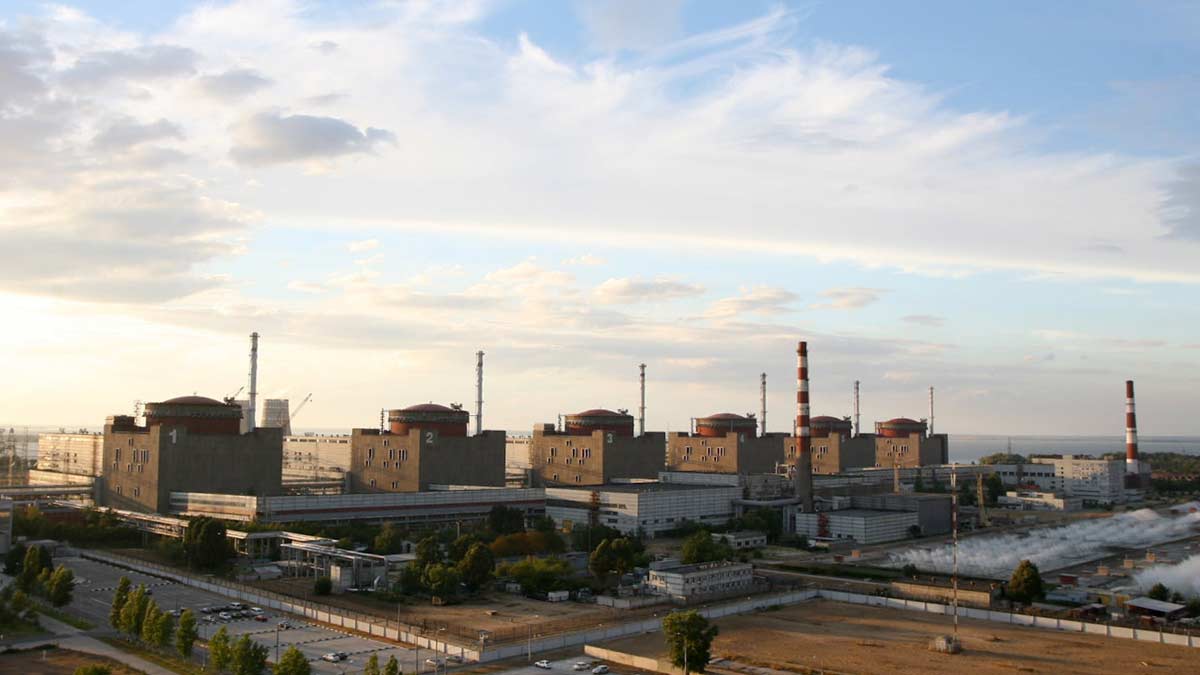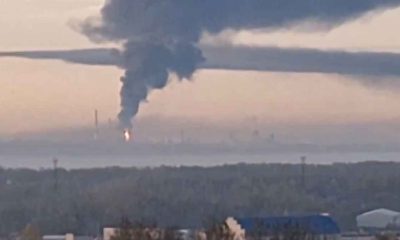Breaking News
Risk of a Nuclear Accident at Ukraine’s Zaporizhzhia Nuclear Power Plant Increases
External power outage at Russian-occupied nuclear power plant enters unprecedented fifth day, increasing meltdown risk.

[Kyiv, Ukraine – WBHG News] –The Zaporizhzhia Nuclear Power Plant (ZNPP) has been without external power for an unprecedented fifth day, increasing the risk of a nuclear accident with each passing hour.
On Saturday, the International Atomic Energy Agency (IAEA) posted on Twitter (X) that the power plant “continues to depend on emergency diesel generators,” adding that ZNPP “has diesel fuel for over 10 days with more supplies available.” On September 25, the IAEA reported that the plant had a 20-day supply of diesel.
This is the tenth “loss of outside power” since Russian forces attacked and occupied ZNPP in March 2022, in violation of Article 56 of International Humanitarian Law. It is the longest any nuclear power plant in the world has had to rely on emergency generators to provide onsite power.
Russian occupiers with Rosatom accused Ukraine of damaging the single 750-kilovolt (kV) line on September 23, cutting off external power. Ukrainian officials denied the allegations, and the IAEA reported on September 25 that its onsite experts were blocked from inspecting the site approximately 1,500 meters from the plant, due to “security concerns.”
Prior to Russia’s occupation of ZNPP, it had six 750 kV and four 330 kV external power connections. Since late 2022, only two lines remained: a 750 kV link from occupied Crimea and a 330 kV line in the Dnipropetrovsk region. On May 9, the 330 kV connection near Nikopol was damaged by a Russian attack. Ukrainian engineers have not been able to repair the line due to constant artillery and drone strikes on the west bank of the Dnipro River.
Thermal power plants rely on external power to support plant operations
All thermal power plants have external electrical connections to provide on-site power. This is a built-in safety feature that enables safe operation in the event the power plant has to shut down. Emergency generators, typically fueled by natural gas or diesel, can provide on-site power in the event that all external connections are severed.
Although all six reactors at ZNPP are in cold shutdown, the nuclear fuel and on-site spent fuel storage require continuous coolant circulation to prevent a meltdown. Following the 2011 Fukushima nuclear accident, all nuclear power plants were required to review their safety plans to ensure that on-site emergency power could be maintained for 72 hours. The outage at ZNPP is unprecedented, putting nuclear safety into uncharted territory.
If a nuclear power plant were to lose off-site and emergency on-site power, it could operate in “island mode.” A reactor would be brought online to provide internal power. This is considered an emergency action of last resort. If the plant were to lose on-site power while in island mode, coolant circulation would stop, which would lead to a meltdown within 24 hours.
All six reactors at ZNPP have been in cold shutdown since 2023. Due to the destruction of the Kakhovka Dam in June 2023, there is insufficient cooling water to bring any of the reactors to an operational state. Additionally, one of two cooling towers was severely damaged by a fire in August 2024. Director General Rafael Grossi and IAEA experts inspected the tower in September of the same year, concluding the fire was accidental and the tower would need to be replaced before the plant could operate again.
When ZNPP lost external power on September 23, 18 on-site diesel-powered emergency generators were activated. Plant operators have since reduced the number of running generators to seven to conserve diesel fuel.
What happens if on-site power is lost
Because the reactors are in cold shutdown, if emergency power at ZNPP were to be lost, it would take another 21 to 25 days for a meltdown to occur. The longer the plant is in total power loss, the more complicated it becomes for plant operators to stop a nuclear accident. The spent nuclear fuel stored on-site would start to burn through its containment after 10 to 14 days.
The six reactors at ZNPP are VVER presurized-water reactors built by the Soviet Union, and have nothing in common with the RBMK reactors at Chornobyl Nuclear Power Plant. Reactor 4 at Chornobyl catastrophically exploded on April 26, 1986, due to a design flaw and the gross negligence of plant operators. The incident caused the worst nuclear accident in history, and left thousands of square kilometers in Ukraine and Belarus heavily contaminated with radioactive fallout.
The Soviet VVER reactors at ZNPP are very similar to Western PWR reactors and have undergone additional modernization by Westinghouse to further enhance their safety. The reactors are also in double containment vessels, unlike Chornobyl, which had no containment structure for its four reactors. There is an inner steel containment vessel, designed to contain a catastrophic reactor explosion, and an outer concrete vessel intended to protect the reactor from external accidents and attacks, as well as containing any potential radiation leaks from the inner vessel.
A partial or total meltdown of any of the reactors would produce the third-worst nuclear accident in history, behind Chornobyl and Fukushima. Due to ZNPP’s location in a war zone and its continued military occupation, a proper civil and technical response would be impossible. In the worst-case scenario, radioactive fallout could extend to Europe, Russia, and the Middle East, depending on the prevailing winds.
Russia has repeatedly violated Article 56 of IHL
Russian attacks have targeted two Ukrainian nuclear facilities since 2022 in Kharkiv and Chornobyl, and threatened the four operating nuclear power plants in Ukraine.
Since March 5, 2022, Russia has attacked the subcritical Neutron Source Research Reactor at the Kharkiv Institute of Physics and Technology 74 times. In November 2022, IAEA General Director Grossi said, “Although radiation levels were normal, the extent of damage to this nuclear research facility is dramatic and shocking, even worse than expected.”
Despite the constant attacks, there has been no radiation release, and Ukrainian scientists continue to support the remains of the research reactor.
On February 14, 2025, a Russian Shahed-136 one-way drone struck the New Safe Confinement (NSC) structure at Chornobyl Nuclear Power Plant, which protects the sarcophagus built around Reactor 4. The attack punched a 15-square-meter hole in the roof and caused a fire that smoldered for two weeks. Debris collected from the site, including the drone’s engine, was consistent with a Russian Shahed. Repairs to the NSC are scheduled to begin by the end of September and are expected to cost up to $65 million.
On September 19, 2022, a Russian missile exploded 300 meters from the reactors at South Ukraine Nuclear Power Plant in the Mykolaiv oblast, damaging an electrical substation and blowing out windows.
On November 24, 2022, Russian missile and drone strikes collapsed Ukraine’s electrical power grid, cutting off external power to all four nuclear power plants, forcing site operators to scram the reactors.
On October 25, 2023, a Russian drone strike near the Khmelnytskyi Nuclear Power Plant blew out windows and damaged external radiation sensors.
On November 16, 2024, Russian missile and drone strikes targeted four critical electrical substations that provide external power to all four of Ukraine’s nuclear power plants. Plant engineers reduced power output as a safety precaution.
On September 25, 2025, Ukrainian air defense shot down a Russian Shahed-136 one-way drone 800 meters from the South Ukraine Nuclear Power Plant. Grossi reported that IAEA inspectors were allowed to visit the impact site and found drone debris and a 4-meter-wide by 1-meter-deep crater. Several other Russian drones flew within 500 meters of the plant.










